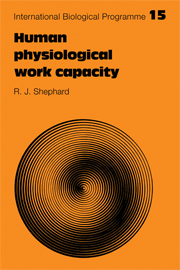Book contents
- Frontmatter
- Contents
- Foreword
- Preface
- 1 Introduction
- 2 Sampling and population studies
- 3 Methods for the measurement of physical fitness, working capacity and activity patterns
- 4 Climate, season and local geography
- 5 Socio-economic status and working capacity
- 6 Working capacity and constitution
- 7 The physical working capacity of the athlete
- 8 The growth of working capacity
- 9 Age and working capacity
- 10 Epilogue
- IBP Human Adaptability section publications
- References
- Index
3 - Methods for the measurement of physical fitness, working capacity and activity patterns
Published online by Cambridge University Press: 20 May 2010
- Frontmatter
- Contents
- Foreword
- Preface
- 1 Introduction
- 2 Sampling and population studies
- 3 Methods for the measurement of physical fitness, working capacity and activity patterns
- 4 Climate, season and local geography
- 5 Socio-economic status and working capacity
- 6 Working capacity and constitution
- 7 The physical working capacity of the athlete
- 8 The growth of working capacity
- 9 Age and working capacity
- 10 Epilogue
- IBP Human Adaptability section publications
- References
- Index
Summary
One of the avowed objectives of the IBP was to develop a common, standardized methodology that could be used by biological scientists in every corner of the world. The need for standardization was particularly evident with respect to the measurement of working capacity. Almost every laboratory had its own design of step or bicycle ergometer and its own characteristic exercise protocol. While many investigators claimed accuracies of 0.01–0.02% for their chemical methods of gas analysis, widely differing results were reported (Cotes & Woolmer, 1962) when laboratories were confronted by a single cylinder mixture (oxygen concentrations were estimated at 15.70–16.21%, and CO2 concentrations at 6.01–6.28%). Perhaps mainly because of systematic errors of gas analysis (Cormack & Heath, 1974), IBP teams noted that maximum oxygen intakes differed by 10% (Bonjer, 1966) or even 25% (G. R. Cumming, 1970) when the same subjects were tested in different laboratories.
Approaches to the standardization of methodology
Recognizing that the choice of test procedure for the measurement of working capacity could prove a controversial issue, the IBP convened a bench-level working party in Toronto in the summer of 1967. The objectives were to evaluate a representative group of possible test procedures, to recommend the optimum protocol for inclusion in the human adaptability handbook, and to make a pilot trial of the chosen methodology on a randomly selected population of schoolchildren.
The results were quite widely publicized (Shephard et al., 1968a, b; Weiner & Lourie, 1969; Shephard, 1970, 1971b).
- Type
- Chapter
- Information
- Human Physiological Work Capacity , pp. 22 - 46Publisher: Cambridge University PressPrint publication year: 1978
- 1
- Cited by



